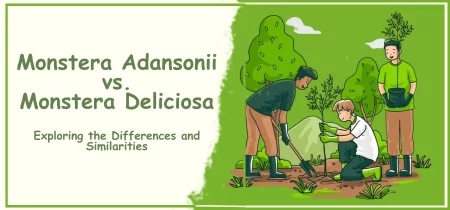Do you need help choosing between the monstera borsigiana vs. deliciosa? Don’t worry; you’re not alone! These two popular monstera plants have a lot of similarities but also some important differences that can affect their care and maintenance.
In this blog post, we’ll explore those differences in detail and help you decide which one is right for you. Understanding the distinctions between these plants is crucial for proper care, as they have unique needs for light, water, soil, temperature, and more.
So, let’s dive in and discover the physical and care differences between Monstera parmigiana vs. deliciosa and find out which is the best fit for your home.
- History and Origin of Monstera Plants
- Physical Differences between Monstera Borsigiana and Deliciosa
- Care and Maintenance of Monstera Borsigiana vs Deliciosa
- Monstera Borsigiana vs. Deliciosa: Which is Easier to Care For?
- Common Problems and Diseases with Monstera Borsigiana and Deliciosa
- Monstera Borsigiana vs. Deliciosa: Which is More Expensive?
- Monstera Borsigiana vs Deliciosa: Which is More Popular?
- Monstera Borsigiana vs Deliciosa: Which is More Unique?
- Monstera Borsigiana vs. Deliciosa: Which is Best for Your Home?
- Frequently Asked Questions
- Conclusion
History and Origin of Monstera Plants
Monstera plants have a rich and fascinating history. Monstera borsigiana and Monstera deliciosa are tropical plants native to Central and South AmericMonstera parmigiana is a smaller version of the more commonly known Monstera deliciosa, but they have different origins.
Monstera borsigiana comes from the rainforests of Southern Mexico. At the same time, Monstera deliciosa is native to the rainforests of Central Americ Monstera deliciosa has existed for thousands of years, as it was discovered by indigenous tribes in the region who used it for medicinal purposes.
The name “deliciosa” comes from the fact that the fruit produced by the plant is considered a delicacy in some regions.
Monstera borsigiana, on the other hand, is a relatively newer discovery, having been found in the wild in the 1950s. It was named after the German botanist Franz Borsig.
The two plants may look similar, but their origins are quite distinct. Understanding the history and origins of these plants can give us a better appreciation for their unique characteristics and how they have evolved.
Whether you are a plant enthusiast or simply looking to add some greenery to your home, knowing the differences between Monstera borsigiana vs. deliciosa can help you choose the right plant for your space.
Physical Differences between Monstera Borsigiana and Deliciosa
Monstera plants have become increasingly popular in recent years, and it’s easy to see why. They’re attractive, easy to care for and add a touch of tropical charm to your home.
We’ll take a closer look at the physical differences between Monstera Borsigiana and Deliciosa to help you make an informed decision.
Size and Height of the Plant
Monstera Deliciosa is generally larger and taller than the Borsigiana variety, reaching up to 20 feet in height in the wilIn comparison, Monstera Borsigiana is a more compact plant, reaching up to 6-8 feet in height under the right conditions.
Shape and Size of the Leaves
The leaves of Monstera Deliciosa are larger and broader, with the iconic split leaves that are so popular in interior design. On the other hand, Monstera Borsigiana has smaller, more compact leaves with fewer splits and holes.
The texture of the Leaves
The texture of the leaves is another significant difference between the two plants. Monstera Deliciosa leaves have a thick, leathery texture, while Monstera Borsigiana leaves are thinner and more delicate.
Color and Appearance of the Leaves
Monstera Deliciosa leaves are darker green and have more defined splits and holes. In comparison, Monstera Borsigiana leaves are lighter in color, with less defined splits and holes.
Differences in Stems and Roots
Monstera Deliciosa has thicker and more substantial stems and aerial roots used to climb trees in their natural habitat. Monstera Borsigiana, however, has thinner stems and less prominent roots.
While both Monstera Borsigiana and Deliciosa are excellent indoor plants, there are noticeable physical differences between them that can help you decide which one is the right fit for your home.
Care and Maintenance of Monstera Borsigiana vs Deliciosa
When caring for Monstera plants, there are a few important factors to consider. Here are the care and maintenance tips for Monstera borsigiana and Monstera deliciosa:
Light Requirements:
Both plants require bright, indirect light to thrive. Avoid placing them in direct sunlight, as it can scorch the leaves.
Watering Needs:
It’s essential to water Monstera plants properly. Allow the soil to dry out slightly between waterings, but don’t let it become bone dry. Overwatering can lead to root rot.
Soil Type:
Use well-draining soil that can retain moisture for both plants. A mix of peat moss, perlite, and orchid bark works well.
Temperature Tolerance:
Both plants can tolerate a wide range of temperatures but prefer warm and humid conditions. Keep them away from cold drafts and air conditioning vents.
Fertilization:
Fertilize both plants once a month during the growing season with a balanced fertilizer. Dilute the fertilizer to half the recommended strength to avoid burning the roots.
F. Pruning and Propagation:
Prune your Monstera plants regularly to maintain their shape and remove damaged leaves. Both plants can be propagated through stem cuttings or by dividing the root ball.
Overall, Monstera plants are relatively easy to care for and make an excellent addition to any indoor garden. By following these tips, you can keep your Monstera borsigiana and Monstera deliciosa happy and healthy.
Monstera Borsigiana vs. Deliciosa: Which is Easier to Care For?
Monstera Borsigiana and Deliciosa are two popular houseplants with striking foliage that have gained a following among plant enthusiasts. But which one is easier to care for?
Factors that Affect Ease of Care
Several factors affect the ease of care for Monstera plants. These include light requirements, watering needs, soil type, temperature tolerance, and fertilization. A plant that can tolerate varying degrees of these factors is easier to care for than one with strict requirements.
Comparison of the Two in Terms of Maintenance
In terms of maintenance, Monstera Borsigiana is generally considered easier to care for than DeliciosBorsigiana is more adaptable to different light conditions and can tolerate lower humidity levels, making it a great choice for beginners.
On the other hand, Deliciosa requires more attention, as it prefers bright indirect light and high humidity levels.
Additionally, Borsigiana is more compact and easier to prune than Deliciosa, which can grow quite large and become unwieldy. Propagation is also simpler with Borsigiana, as it produces more pups and is generally more tolerant of different soil types.
Overall, while both Monstera Borsigiana and Deliciosa are beautiful plants, Borsigiana may be the better choice for those looking for an easier-to-care-for houseplant.
Common Problems and Diseases with Monstera Borsigiana and Deliciosa
Monstera Borsigiana and Deliciosa are beautiful and popular plants that are easy to care for, but like all plants, they are not immune to problems and diseases.
Here are some of the most common issues you may encounter when growing these plants and some tips for preventing and treating them.
Pests and Diseases
- Mealybugs: These tiny insects feed on the plant’s sap and leave behind a sticky residue. You may notice small white or yellowish dots on the leaves, which can cause them to curl or turn yellow. To treat, wipe down the leaves with a damp cloth, or use insecticidal soap.
- Spider Mites: These pests are common in dry environments and can cause the leaves to turn yellow and drop. To prevent them, keep the air humid and mist the leaves regularly. Use a miticide if you notice spider mites.
- Root Rot: This is caused by overwatering or poorly draining soil and can cause the leaves to wilt and turn yellow. To prevent this, ensure the soil is well-draining, and avoid overwatering.
Tips for Prevention and Treatment
- Keep the plant in a well-lit area, but avoid direct sunlight.
- Water the plant only when the soil is dry to the touch.
- Use well-draining soil, and avoid overwatering.
- Fertilize the plant regularly with a balanced fertilizer.
By following these tips and monitoring your Monstera plants regularly, you can help prevent and treat any problems, ensuring that your plants thrive and stay healthy.
Monstera Borsigiana vs. Deliciosa: Which is More Expensive?
Monstera Borsigiana and Deliciosa are two popular houseplants that have gained a lot of attention lately. If you’re looking to buy one of these plants, you may be wondering which one is more expensive. Let’s take a closer look.
Factors that Affect the Price
The price of a Monstera plant can vary depending on several factors. These include the plant’s size, age, rarity, and location. In general, the larger the plant, the more expensive it will be. Similarly, older plants may command a higher price due to their maturity.
Rare varieties of Monstera may also be more expensive than common ones, and location can affect the price due to shipping and availability.
Comparison of the Two in Terms of Price
When it comes to comparing Monstera Borsigiana and Deliciosa in terms of price, it’s difficult to make a definitive statement.
Both plants can be found at a range of price points depending on the factors listed above. However, in general, Monstera Deliciosa may be slightly more expensive due to its popularity and larger size.
The price of a Monstera plant can vary widely depending on several factors. While Monstera Deliciosa may be slightly more expensive on average, it’s important to shop around and consider all factors before making a purchase.
Monstera Borsigiana vs Deliciosa: Which is More Popular?
When it comes to houseplants, the Monstera genus is incredibly popular and trendy. Among the most sought-after Monstera plants are the Borsigiana and Deliciosa varieties. But which one is more popular?
Social Media Popularity
Both Monstera Borsigiana and Deliciosa have a significant presence on social media platforms like Instagram and Pinterest. However, the Deliciosa variety tends to have a larger following and is often considered more of a statement plant due to its large and unique leaves.
Sales and Demand
In terms of sales and demand, the Deliciosa variety is more popular and tends to be more expensive. Its unique shape and size make it a statement piece in any room, which has led to increased demand and higher prices.
Personal Experience
As a plant enthusiast and collector, I have noticed that the Deliciosa variety is often sold out and harder to find in nurseries and plant shops. On the other hand, I have seen more availability of the Borsigiana variety.
While both Monstera Borsigiana and Deliciosa are popular plants, the Deliciosa variety has a larger following on social media and is more in demand, which often translates to higher prices. However, availability may vary depending on your location and local nurseries.
Monstera Borsigiana vs Deliciosa: Which is More Unique?
Monstera plants have gained popularity over the years due to their unique foliage, which makes them stand out among other houseplants. In this article, we will compare Monstera Borsigiana and Deliciosa in terms of their uniqueness.
Uncommon Varieties of Monstera Plants
Several rare and uncommon varieties of Monstera plants exist, such as the Monstera Obliqua, which has holes in its leaves so large that it’s also known as the “Swiss Cheese Plant.”
Another rare variety is the Monstera Adansonii, also known as the “Swiss Cheese Vine,” due to its smaller leaves and vining habit.
Comparison of the Two in Terms of Uniqueness
While both Monstera Borsigiana and Deliciosa have unique foliage, the Deliciosa variety is generally more well-known due to its large and dramatic leaves with distinct splits and holes.
However, the Borsigiana variety is unique in its way, with slightly smaller leaves that are darker green and more compact, making it an ideal choice for smaller spaces or those who prefer a more understated look.
Both Monstera Borsigiana and Deliciosa are unique in their ways, and choosing between them ultimately depends on personal preference and the specific needs of your space.
Monstera Borsigiana vs. Deliciosa: Which is Best for Your Home?
If you want to add a touch of greenery to your home decor, Monstera plants are a great choice. However, choosing between Monstera Borsigiana and Deliciosa can be challenging. Here are some factors to consider when deciding which plant is best for your home.
Factors to Consider When Choosing a Monstera Plant:
- Size: The Deliciosa grows larger than the Borsigiana, so it may not be the best choice if you have limited space.
- Light: Both plants require bright, indirect light, but the Deliciosa can handle slightly more direct sunlight.
- Care: The Borsigiana is generally easier to care for, making it a great choice for beginners.
- Price: The Deliciosa tends to be more expensive due to its popularity and larger size.
Comparison of the Two in Terms of Home Decor:
- The Deliciosa’s large, unique leaves make it a statement piece in any room, while the Borsigiana’s smaller leaves can be used in groupings or as part of a plant collection.
- Both plants can add a tropical vibe to your home, but the Deliciosa’s larger size can make it a focal point in a room.
Ultimately, the best choice between the Monstera Borsigiana and Deliciosa comes down to your preferences and the factors listed above.
Consider the size of your space, your level of care experience, and the overall aesthetic you want to achieve when making your decision.
Frequently Asked Questions
How do I know if my Monstera Borsigiana or Deliciosa is getting enough light?
Monstera plants thrive in bright, indirect light. If the leaves turn yellow or brown, it could be a sign of too much direct sunlight. If the leaves are smaller than usual and spaced further apart, it could be a sign of insufficient light.
Why are the leaves on my Monstera plant turning yellow?
Yellow leaves on a Monstera plant could be a sign of overwatering, underwatering, or too much direct sunlight. Check the soil moisture level and adjust the watering accordingly. Move the plant to a spot with less direct sunlight if necessary.
How do I propagate my Monstera Borsigiana or Deliciosa?
Monstera plants can be propagated through stem cuttings. Choose a healthy stem and make a clean cut just below a node. Place the cutting in water or soil and keep it moist until it develops roots.
Why are the leaves on my Monstera plant developing brown spots?
Brown spots on Monstera leaves could be a sign of fungal infection or pest infestation. Check the leaves for signs of spider mites or mealybugs. Remove infected leaves and treat the plant with a fungicide if necessary.
Conclusion
In summary, Monstera Borsigiana and Deliciosa are two popular houseplants with some similarities but also some notable differences.
Monstera Deliciosa is larger and has split leaves, while Monstera Borsigiana is smaller and has smaller, more solid leaves. Additionally, Monstera Borsigiana is generally more affordable than Deliciosa.
When choosing the right Monstera plant for your home, it’s important to consider factors such as the amount of space you have, your budget, and your personal style preferences.
Both Monstera Borsigiana and Deliciosa are great choices for adding some greenery to your space, but ultimately, it’s up to you to decide which one best fits your needs.
Whether you choose Monstera Borsigiana, Deliciosa, or any other variety of Monstera, these plants are sure to make a beautiful addition to your home decor.




Leave a Reply